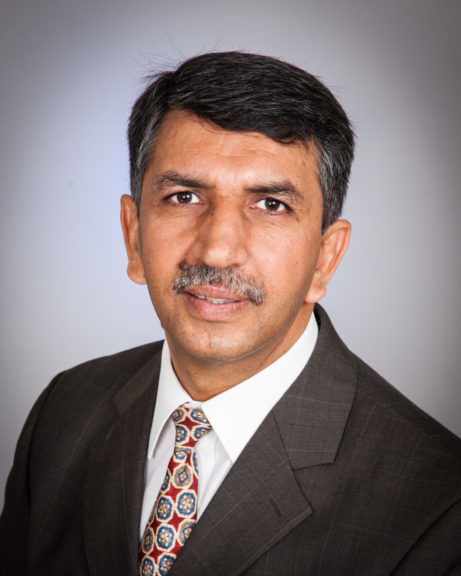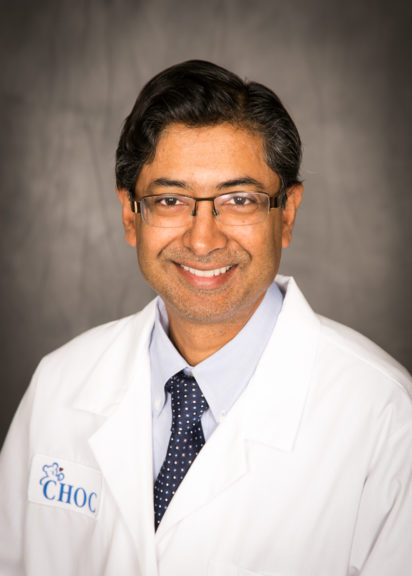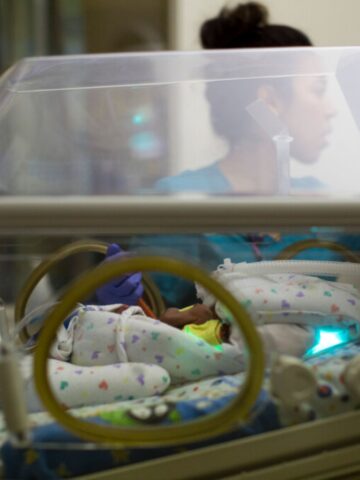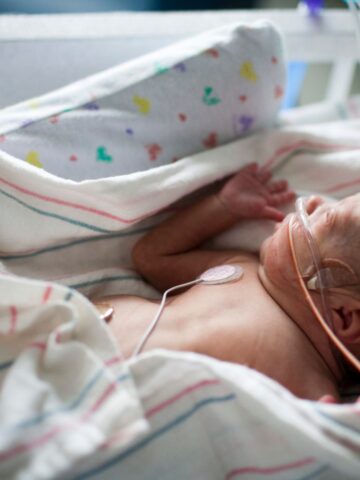Innovative silo treatment utilizing umbilical cords for gastroschisis at CHOC
Previously, repairing gastroschisis, a congenital anomaly characterized by protrusion of the intestines through a hole in the abdominal wall, required surgery in the operating room to close the defect with sutures. Now, at Children’s Hospital of Orange County (CHOC), University of California, Irvine, Medical Center and other centers, the preferred method for most patients is sutureless repair using the umbilical cord to cover the defect.
Dr. Saeed Awan, board-certified pediatric surgeon at CHOC and UCI and clinical professor at the University of California, Irvine, introduced sutureless gastroschisis repair to CHOC in 2014 after performing it in Canada for more than five years. At CHOC, this procedure takes place in the Surgical NICU, the only one of its kind on the West Coast.

“A major benefit of sutureless gastroschisis repair is you’re doing it at the bedside,” Dr. Awan says. “You don’t have to anesthetize the baby [and] they don’t need to be ventilated in the majority of cases.” Babies also experience less pain with this procedure.
Multidisciplinary management of gastroschisis at CHOC
Approximately one in every 2,000 babies born annually in the U.S are diagnosed with gastroschisis. A multidisciplinary team at CHOC cares for around five to 10 cases per year, many of which are diagnosed via fetal ultrasound at the Fetal Care Center of Southern California.
As a pediatric surgeon, Dr. Awan typically becomes involved with gastroschisis cases between 25 and 30 weeks of gestation.
“We initiate an appointment where the pediatric surgeon, neonatologist and perinatologist see the family together.” Dr. Awan says. “We explain to them what will happen once the baby is born. After birth, there’s no difference in initial management based on whether the baby will have a sutureless or sutured closure.”
The priorities, Dr. Awan says, are to prevent twisting of the intestines, which could cause vascular compromise and injury to intestines. They also need to maintain a stable temperature and hydration status.

“Once the baby is delivered, we wrap the intestines in a sterile plastic bag, bring the baby to the NICU and get our surgeons involved,” says Dr. Irfan Ahmad, board-certified neonatologist and medical director of the Surgical NICU at CHOC.
“The surgeons like to have a good look at the intestines because, sometimes, there can be areas of obstruction or intestinal abnormality, like atresia, in which case they have to perform surgical repair. Otherwise, if the intestine looks okay, the surgeon can do one of two things, depending on how much intestine is outside and how much space is inside the abdomen: immediate repair or delayed repair by placing the intestine in a plastic bag covering called silo.”
Delayed sutureless repair for gastroschisis
After placement of a silo to protect the intestines, Dr. Awan prefers to delay the repair for 24 to 48 hours while reducing the organs into the abdomen.
“If I’m going to do a sutureless closure, even if I know I can do it, I don’t do it right away,” he says. “I wait at least 24 hours because, by that time, some of the edema that happened during the birth gets better, and then I have more space [in the abdominal cavity].”
During the repair procedure, after pushing the intestines back into the abdominal space and removing the spring-loaded silo, the team pulls the umbilical cord to the side to cover the defect, which is almost always located on the right side.
“At its bottom, the umbilical cord has some skin on either side, and with that, we pull the cord over,” Dr. Awan says. “Once we pull it over, that triangle of skin covers the defect the majority of the time.”
A topical adhesive, adhesive strips and a medical dressing hold the umbilical cord in place while the defect heals. Steristrips are removed and replaced three or four days later and the mepliex dressing will be removed. After seven to ten days, all dressings are removed completely.
In addition to the benefits of avoiding surgery, anesthetization and ventilation, Dr. Awan points to improved cosmesis as an advantage of sutureless repair compared with surgical repair.
More expansive future for gastrochisis closures
Dr. Ahmad says the multidisciplinary team at CHOC has been extremely pleased with the results of sutureless gastroschisis closure over the past 10 years.
“We’re constantly meeting among our different specialties and asking a fundamental question: ‘How can we achieve better outcomes using less invasive techniques?’” he says. “At the end of the day, you want to achieve the best possible result and take the minimum amount of risk. By managing these infants without exposure to anesthesia and ventilators, it is easier to resume normal feeding and get them home as early as we can. There’s also less chance of anesthesia and postsurgical complications.”
Umbilical hernia, already quite common in babies, is a frequent side effect of sutureless gastroschisis repair due to manipulation of the umbilical cord, Dr. Awan explains. Interestingly, however, he has observed that umbilical hernias in babies who had sutureless gastroschisis repair close on their own faster than in babies with hernias unrelated to gastroschisis repair.
As a result, the possibility of an umbilical hernia isn’t a concern to surgeons and shouldn’t be an impediment to wider use of sutureless gastroschisis repair.
“As my colleagues become more accustomed to this technique, we could do more sutureless gastroschisis repairs in the future,” Dr. Awan says. “Even bigger defects or more delayed cases could be repaired in a sutureless way.”

Learn more about the Fetal Care Center of Southern California
As a partnership between UCI Health and CHOC, The Fetal Care Center of Southern California brings together experts in maternal-fetal medicine and pediatrics, so both mom and baby are cared for — no matter the diagnosis.




